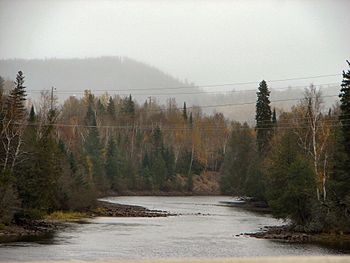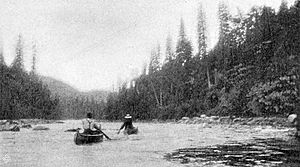Michipicoten River facts for kids
Quick facts for kids Michipicoten River |
|
|---|---|

Michipicoten River as seen from Highway 101
|
|
| Country | Canada |
| Province | Ontario |
| Region | Algoma District |
| Physical characteristics | |
| Main source | Dog Lake 15 km SW of Missanabie, Ontario 330 m (1,080 ft) 48°13′55″N 84°13′15″W / 48.23194°N 84.22083°W |
| River mouth | Michipicoten Bay of Lake Superior Michipicoten, Ontario 183 m (600 ft) 47°56′00″N 84°51′00″W / 47.93333°N 84.85000°W |
| Length | 81 km (50 mi) |
| Basin features | |
| Basin size | 5,200 km2 (2,000 sq mi) |
The Michipicoten River is a river in northern Ontario, Canada. It starts at Dog Lake. The river then flows into Michipicoten Bay. This bay is part of Lake Superior, near the town of Wawa.
The river is about 113 km (70 mi) long. It drains a large area of land, about 5,200 km2 (2,000 sq mi). The name Michipicoten comes from the Ojibwe words Mishipikwadina. This means "big bluffs," which refers to the tall hills near where the river meets Lake Superior.
From Dog Lake, the Michipicoten River flows south. It passes through big lakes like Manitowik and Whitefish. Then, it mostly flows west towards Lake Superior. There are four power plants on this part of the river. These plants use the river's water to make hydroelectric power. They are run by Brookfield Power Inc.
Contents
History of the Michipicoten River
The Michipicoten River has a long and interesting history. It was important for travel and trade for hundreds of years.
Early Explorers and Fur Trade
The French explorer Samuel de Champlain drew the Michipicoten River on a map in 1632. This shows how early Europeans knew about it. Later, the river became a key route during the fur trade. It connected to James Bay through the Missinaibi and Moose rivers.
Explorers Pierre-Esprit Radisson and Médard des Groseilliers were likely the first non-native people to use this route. In the early 1700s, a French fur trading post was built at the river's mouth. This place was sometimes called "Fort Michipicoten."
After the British won the French and Indian War, the French post was left empty. But the British reopened it later in the 1700s. The Hudson's Bay Company (HBC) and North West Company both set up trading posts there. The HBC also built posts along the river's path in the 1770s.
In 1781, Philip Turnor, an HBC surveyor, mapped the river in detail. He also helped improve the portages (places where boats had to be carried over land). In 1821, the two big fur companies joined together. The Michipicoten River route became the main way to supply the HBC's Lake Superior area. This changed the fur trade to focus on Hudson Bay instead of Montreal.
Railways and Gold Rush
In the 1880s, the Canadian Pacific Railway (CPR) was being built. Building materials were brought to the mouth of the Michipicoten River. They were then moved upriver, sometimes by steamboat on Wawa Lake. The new railway line ran far from the river. This made the Michipicoten River trading post less important.
Around the year 1900, there was a short-lived gold rush in the area. Towns like Wawa grew quickly because of this. But when the gold rush ended, plans for a "Michipicoten City" failed. The old trading post was finally closed in 1904. Today, its site is part of Michipicoten Post Provincial Park.
Michipicoten High Falls and Power
The Michipicoten River once had a beautiful series of waterfalls. These were called Michipicoten High Falls and were about 27 m (89 ft) tall. In 1904, people started building a dam and a power plant there. The goal was to provide electricity to nearby mines, like the Helen Mine.
The dam was finished in 1907. When the lake behind it filled up, the waterfalls disappeared. The power plant was improved in 1926. This was because people expected another gold mining boom. This second boom brought more people and development to new mining towns. These towns were known as Gold Park. This also meant that older settlements along the river became less important.
River Branches (Tributaries)
A tributary is a smaller river or stream that flows into a larger river. Here are some of the rivers and lakes that flow into the Michipicoten River:
- Magpie River
- Anjigami River
- Shikwamkwa River
- Jackpine River
- Hawk River
- Dog Lake
- Murray Creek
- Dog River
- Lochalsh River


